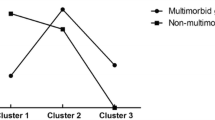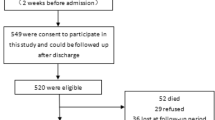Abstract
OBJECTIVE: To describe functional deficits among older adults living alone and receiving home nursing following medical hospitalization, and the association of living alone with lack of functional improvement and nursing home utilization 1 month after hospitalization.
DESIGN: Secondary analysis of a prospective cohort study.
PARTICIPANTS: Consecutive sample of patients age 65 and over receiving home nursing following medical hospitalization. Patients were excluded for new diagnosis of myocardial infarction or stroke in the previous 2 months, diagnosis of dementia if living alone, or nonambulatory status. Of 613 patients invited to participate, 312 agreed.
MEASUREMENTS: One week after hospitalization, patients were assessed in the home for demographic information, medications, cognition, and self-report of prehospital and current mobility and function in activities of daily living (ADLs) and independent activities of daily living (IADLs). One month later, patients were asked about current function and nursing home utilization. The outcomes were lack of improvement in ADL function and nursing home utilization 1 month after hospitalization.
RESULTS: One hundred forty-one (45%) patients lived alone. After hospital discharge, 40% of those living alone and 62% of those living with others had at least 1 ADL dependency (P=.0001). Patients who were ADL-dependent and lived alone were 3.3 (95% confidence interval [95% CI], 1.4 to 7.6) times less likely to improve in ADLs and 3.5 (95% CI, 1.0 to 11.9) times more likely to be admitted to a nursing home in the month after hospitalization.
CONCLUSION: Patients who live alone and receive home nursing after hospitalization are less likely to improve in function and more likely to be admitted to a nursing home, compared with those who live with others. More intensive resources may be required to continue community living and maximize independence.
Similar content being viewed by others
References
Hirsch CH, Sommers L, Olsen A, Mullen L, Winograd CH. The natural history of functional morbidity in hospitalized older patients. J Am Geriatr Soc. 1990;38:1296–1303.
McVey LJ, Becker PM, Saltz CC, Feussner JR, Cohn HJ. Effect of a geriatric consultation team on functional status in elderly hospitalized patients. Ann Intern Med. 1989;110:78–84.
Sager MA, Franke T, Inouye SK, Landefeld S, Morgan TM, Rudberg MA et al. Functional outcomes of acute medical illness and hospitalization in older persons. Arch Intern Med. 1996;156:645–52.
Sager MA, Rudberg MA, Jalaluddin M, et al. Hospital admission risk profile (HARP): identifying older patients at risk for functional decline following acute medical illness and hospitalization. J Am Geriatr Soc. 1996;44:251–7.
Covinsky KE, Justice AC, Rosenthal GE, Palmer RM, Landefeld CS. Measuring prognosis and case mix in hospitalized elders: the importance of functional status. J Gen Intern Med. 1997;12:203–8.
Lamont CT, Sampson S, Matthias R, Kane R. The outcome of hospitalization for acute illness in the elderly. J Am Geriatr Soc. 1983;31:282–8.
Wu AW, Damiano AM, Lynn J, et al. Predicting future functional status for seriously ill hospitalized adults: the SUPPORT prognostic model. Ann Intern Med. 1995;122:342–50.
Wachtel TJ, Fulton JP, Goldfarb J. Early prediction of discharge disposition after hospitalization. Gerontologist. 1987;27:98–102.
Narain P, Rubenstein LZ, Wieland GD, et al. Predictors of immediate and 6-month outcomes in hospitalized elderly patients: the importance of functional status. J Am Geriatr Soc. 1988;36:775–83.
Rudberg MA, Sager MA, Zhang J. Risk factors for nursing home use after hospitalization for medical illness. J Gerontol. 1996;51:M189–94.
Oxman TE, Hull JG. Social support, depression, and activities of daily living in older heart surgery patients. J Gerontol. 1997;52B:P1–14.
Verbrugge LM, Balaban DJ. Patterns of change in disability and well-being. Med Care 1989;27(suppl):S128–47.
Wilcox VL, Kasl SV, Berkman LF. Social support and physical disability in older people after hospitalization: a prospective study. Health Psychol. 1994;13:170–9.
Mahoney J, Drinka TJK, Abler R, et al. Screening for depression: single question vs. GDS. J Am Geriatr Soc. 1994;42:1006–8.
Folstein MF, Folstein SE, McHugh PR. “Mini-mental state”: a practical method for grading the cognitive state of patients for the clinician. J Psychiatr Res. 1975;12:189–98.
Katz S, Downs TD, Cash HR, Grotz RC. Progress in development of the index of ADL. Gerontologist. 1970;10:20–30.
Lawton MP, Brody EM. Assessment of older people: self-maintaining and instrumental activities of daily living. Gerontologist. 1969;9:179–86.
Glazebrook K, Rockwood K, Stole P, Fisk J, Gray JM. A case control study of the risks for institutionalization of elderly people in Nova Scotia. Can J Aging. 1994;13:104–17.
Wachtel TJ, Derby C, Fulton C. Predicting the outcome of hospitalization for elderly persons: home versus nursing home. Southern Med J. 1984;77:1283–5.
Wolinsky FD, Callahan CM, Fitzgerald JF, Johnson RJ. The risk of nursing home placement and subsequent death among older adults. J Gerontol. 1992;47:S172–82.
Branch LG, Jette AM. A prospective study of long-term care institutionalization among the aged. Am J Public Health. 1982;72:1373–9.
Jette AM, Branch LG, Sleeper LA, Feldman H, Sullivan LM. High-risk profiles for nursing home admission. Gerontologist. 1992;32:634–40.
Greene VL, Ondrich JI. Risk factors for nursing home admissions and exits: a discrete-time hazard function approach. J Gerontol. 1990;45:S250–8.
Winograd CH, Lindenberger EC, Chavez CM, Mauricio MP, Shi H, Bloch DA. Identifying hospitalized older patients at varying risk for physical performance decline: a new approach. J Am Geriatr Soc. 1997;45:604–9.
Femia EE, Zarit SH, Johansson B. Predicting change in activities of daily living: a longitudinal study of the oldest old in Sweden. J Gerontol B Psychol. 1997;53:294–302.
Mahoney J, Sager MA, Jalaluddin M. Use of an ambulation assistive device predicts functional decline associated with hospitalization. J Gerontology. 1999;54A:M83–8.
Covinsky KE, Fortinsky RH, Palmer RM, Kresevic DM, Landefeld CS. Relation between symptoms of depression and health status outcomes in acutely ill hospitalized older persons. Ann Intern Med. 1997;126:417–25.
Lachman ME, Howland J, Tennstedt S, Jette A, Assmann S, Peterson EW. Fear of falling and activity restriction: the survey of activities and fear of falling in the elderly (SAFE). J Gerontol. 1998;53B:P43–50.
Powell LE, Myers AM. The Activities-specific Balance Confidence (ABC) scale. J Gerontol. 1995;50A:M28–34.
Tinetti ME, Richman D, Powell L. Falls efficacy as a measure of fear of falling. J Gerontol. 1990;45:P239–43.
Welch HG, Wennberg DE, Welch WP. The use of medicare home health care services. N Engl J Med. 1996;335:324–9.
Sager MA, Dunham NC, Schwantes A, Mecum L, Halverson K, Harlowe D. Measurement of activities of daily living in hospitalized elderly: a comparison of self-report and performance-based methods. J Am Geriatr Soc. 1992;40:457–62.
Rubenstein LZ, Schairer C, Wieland GD, Kane R. Systematic biases in functional status assessment of elderly adults: effects of different data sources. J Gerontol. 1984;39:686–91.
Reuben DB, Siu AL, Kimpau S. The predictive validity of self-report and performance-based measures of function and health. J Gerontol. 1992;47:M106–10.
Elam JT, Graney MJ, Beaver T, el Derwi D, Applegate WB, Miller ST. Comparison of subjective ratings of function with observed functional ability of frail older persons. Am J Public Health. 1991;81:1127–30.
Chadiha LA, Proctor EK, Morrow-Howell N, Darkwa OK, Dore P. Post-hospital home care for African-American and white elderly. Gerontologist. 1995;35:233–9.
Solomon DH, Wagner DR, Marenberg ME, Acampora D, Cooney LM, Inouye SK. Predictors of formal home health care use in elderly patients after hospitalization. J Am Geriatr Soc. 1993;41:961–6.
Mahoney J, Sager M, Dunham NC, Johnson J. Risk of falls after hospital discharge. J Am Geriatr Soc. 1994;42:269–74.
Author information
Authors and Affiliations
Additional information
This work was supported by grants from the American Physical Therapy Foundation, the Dean Foundation, and the University of Wisconsin Medical School and Graduate School. Dr. Mahoney was the recipient of a Clinical Investigator Award from the NIA (K08AG00623).
Rights and permissions
About this article
Cite this article
Mahoney, J.E., Eisner, J., Havighurst, T. et al. Problems of older adults living alone after hospitalization. J GEN INTERN MED 15, 611–619 (2000). https://doi.org/10.1046/j.1525-1497.2000.06139.x
Issue Date:
DOI: https://doi.org/10.1046/j.1525-1497.2000.06139.x




